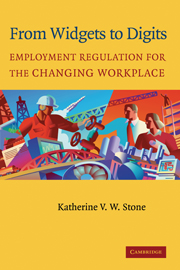Book contents
- Frontmatter
- Contents
- Preface
- Introduction
- PART I LABOR RELATIONS REGIMES OF THE PAST
- PART II THE DIGITAL WORKPLACE
- PART III IMPLICATIONS OF DIGITAL JOB STRUCTURES FOR LABOR AND EMPLOYMENT LAW
- 6 Implications of the New Workplace for Labor and Employment Regulation
- 7 Disputes over Ownership of Human Capital
- 8 The Changing Nature of Employment Discrimination
- 9 Unionism in the Boundaryless Workplace
- 10 Reimagining Employee Representation
- PART IV SOCIAL JUSTICE IN THE DIGITAL ERA
- Summary and Conclusion
- Index
9 - Unionism in the Boundaryless Workplace
Published online by Cambridge University Press: 14 January 2010
- Frontmatter
- Contents
- Preface
- Introduction
- PART I LABOR RELATIONS REGIMES OF THE PAST
- PART II THE DIGITAL WORKPLACE
- PART III IMPLICATIONS OF DIGITAL JOB STRUCTURES FOR LABOR AND EMPLOYMENT LAW
- 6 Implications of the New Workplace for Labor and Employment Regulation
- 7 Disputes over Ownership of Human Capital
- 8 The Changing Nature of Employment Discrimination
- 9 Unionism in the Boundaryless Workplace
- 10 Reimagining Employee Representation
- PART IV SOCIAL JUSTICE IN THE DIGITAL ERA
- Summary and Conclusion
- Index
Summary
The new employment relationship and its corresponding job structures were initially constructed in nonunion environments, and they continue to operate almost exclusively in nonunion environments to this day. Hewlett Packard, TRW, and the General Electric Company (GE) are three leading exemplars of the new work practices described in Chapter 5. Hewlett Packard and TRW have always been nonunion, and GE engaged in aggressive deunionization efforts in some of its plants, and then instituted boundaryless workplace practices after the unions had been eliminated. The sequence of deunionization first, workplace restructuring later, was commonplace in many large corporations in the 1980s. As discussed in Part I, the same sequence characterized industrial relations practices in major corporations in the late nineteenth and early twentieth centuries when internal labor markets were first established. At that time, employers first broke the unions and then instituted Taylorism and other work rationalization measures. Like the implementation of scientific management in the early twentieth century, today's boundaryless workplaces are being created in the vacuum left by the deunionization drives of the previous decade.
In the past twenty years, union density in the private sector declined from almost 16.5 percent in 1983 to 9.0 percent in 2001. This decline is particularly striking in light of the fact that during most of that period, workers' real wages were declining, so that one might have expected aggressive organizing activity and union growth. The union decline was most pronounced in large manufacturing firms in which internal labor markets had been the most deeply entrenched.
- Type
- Chapter
- Information
- From Widgets to DigitsEmployment Regulation for the Changing Workplace, pp. 196 - 216Publisher: Cambridge University PressPrint publication year: 2004



